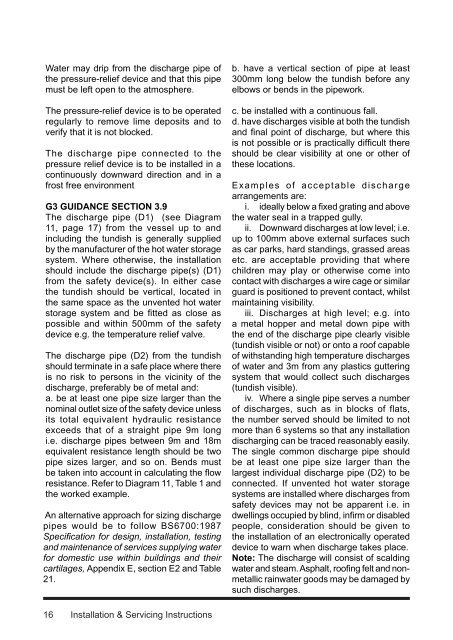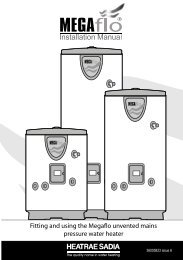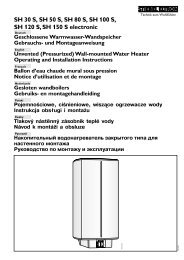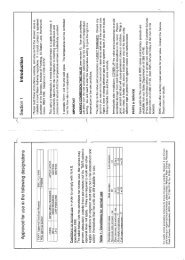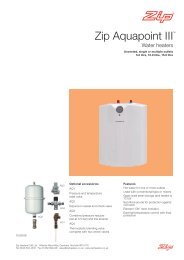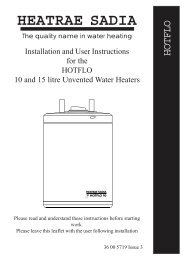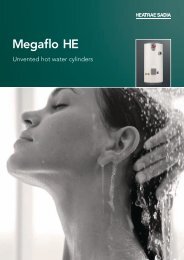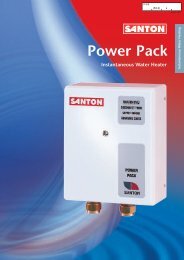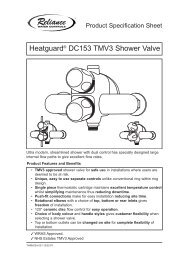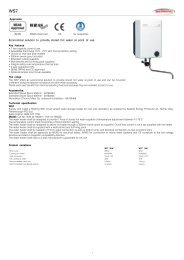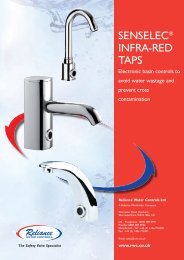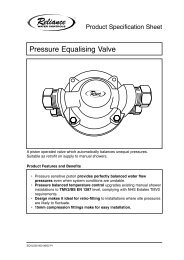Heatrae Sadia Electromax Installation Guide - Advanced Water
Heatrae Sadia Electromax Installation Guide - Advanced Water
Heatrae Sadia Electromax Installation Guide - Advanced Water
You also want an ePaper? Increase the reach of your titles
YUMPU automatically turns print PDFs into web optimized ePapers that Google loves.
<strong>Water</strong> may drip from the discharge pipe of<br />
the pressure-relief device and that this pipe<br />
must be left open to the atmosphere.<br />
The pressure-relief device is to be operated<br />
regularly to remove lime deposits and to<br />
verify that it is not blocked.<br />
The discharge pipe connected to the<br />
pressure relief device is to be installed in a<br />
continuously downward direction and in a<br />
frost free environment<br />
<br />
The discharge pipe (D1) (see Diagram<br />
11, page 17) from the vessel up to and<br />
including the tundish is generally supplied<br />
by the manufacturer of the hot water storage<br />
system. Where otherwise, the installation<br />
should include the discharge pipe(s) (D1)<br />
from the safety device(s). In either case<br />
the tundish should be vertical, located in<br />
the same space as the unvented hot water<br />
<br />
possible and within 500mm of the safety<br />
device e.g. the temperature relief valve.<br />
The discharge pipe (D2) from the tundish<br />
should terminate in a safe place where there<br />
is no risk to persons in the vicinity of the<br />
discharge, preferably be of metal and:<br />
a. be at least one pipe size larger than the<br />
nominal outlet size of the safety device unless<br />
its total equivalent hydraulic resistance<br />
exceeds that of a straight pipe 9m long<br />
i.e. discharge pipes between 9m and 18m<br />
equivalent resistance length should be two<br />
pipe sizes larger, and so on. Bends must<br />
<br />
resistance. Refer to Diagram 11, Table 1 and<br />
the worked example.<br />
An alternative approach for sizing discharge<br />
pipes would be to follow BS6700:1987<br />
<br />
<br />
<br />
Appendix E, section E2 and Table<br />
21.<br />
b. have a vertical section of pipe at least<br />
300mm long below the tundish before any<br />
elbows or bends in the pipework.<br />
c. be installed with a continuous fall.<br />
d. have discharges visible at both the tundish<br />
but where this<br />
<br />
should be clear visibility at one or other of<br />
these locations.<br />
Examples of acceptable discharge<br />
arrangements are:<br />
<br />
the water seal in a trapped gully.<br />
ii. Downward discharges at low level; i.e.<br />
up to 100mm above external surfaces such<br />
as car parks, hard standings, grassed areas<br />
etc. are acceptable providing that where<br />
children may play or otherwise come into<br />
contact with discharges a wire cage or similar<br />
guard is positioned to prevent contact, whilst<br />
maintaining visibility.<br />
iii. Discharges at high level; e.g. into<br />
a metal hopper and metal down pipe with<br />
the end of the discharge pipe clearly visible<br />
(tundish visible or not) or onto a roof capable<br />
of withstanding high temperature discharges<br />
of water and 3m from any plastics guttering<br />
system that would collect such discharges<br />
(tundish visible).<br />
iv. Where a single pipe serves a number<br />
of discharges, such as in blocks of flats,<br />
the number served should be limited to not<br />
more than 6 systems so that any installation<br />
discharging can be traced reasonably easily.<br />
The single common discharge pipe should<br />
be at least one pipe size larger than the<br />
largest individual discharge pipe (D2) to be<br />
connected. If unvented hot water storage<br />
systems are installed where discharges from<br />
safety devices may not be apparent i.e. in<br />
<br />
people, consideration should be given to<br />
the installation of an electronically operated<br />
device to warn when discharge takes place.<br />
Note: The discharge will consist of scalding<br />
<br />
metallic rainwater goods may be damaged by<br />
such discharges.<br />
16 <strong>Installation</strong> & Servicing Instructions


